Panhandle Terrapin Project
Project Goal: To assess the status of the diamondback terrapin in the Florida Panhandle.
Since 2005, Florida Sea Grant has worked with partners and trained volunteers to assess the status of the diamondback terrapin in the Florida Panhandle.
Each spring, volunteers survey selected salt marsh beaches in the Florida Panhandle for evidence of terrapin nesting. They assess distribution, nesting, and how terrapins are using local salt marsh habitat. This data helps determine how many terrapins are in the area to help guide policy and conservation efforts to support the protection of the species.
The project has three objectives: (1) to survey known (primary) nesting beaches for nesting activity; the number of nests, tracks, and depredated nests can be used to calculate a relative abundance of terrapins using beaches, (2) to survey potential (secondary) nesting beaches for any presence of nesting activity, and (3) to tag terrapins using the old notch method, PIT tags, and a small few with satellite tags. This helps track terrapin movement and better understand how they use the habitat.
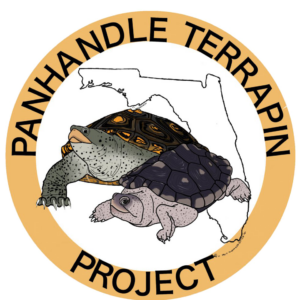
Geographic Scope:
- Escambia County
- Santa Rosa County
- Okaloosa County
- Walton County
- Bay County
- Gulf County
- Franklin County
Volunteer Activities:
- Survey beaches for terrapin nesting
- Follow survey protocol
- Capture and tagging terrapins
Agency Partners:


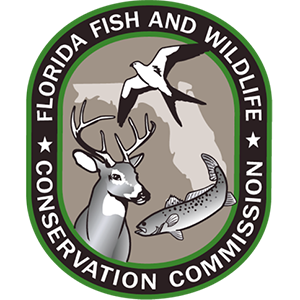
Share This Project
featured video
Tracking
Terrapins
Diamonds in the Florida Panhandle
Since 2005, Florida Sea Grant has managed volunteers collecting data about the diamondback terrapin in the Florida Panhandle.
What To Expect
UF/IFAS Extension and Florida Sea Grant conducts volunteer trainings in March, as volunteers survey their assigned beaches from April 1 to September 30. Volunteers may be required to have their own paddle craft.
To assess terrapin population status, volunteers follow a method developed by Tom Mann with the Mississippi Department of Wildlife. The survey model includes walking nesting beaches and logging individual tracks and depredated nests in 16-day cycles. The model assumes that all mature females in the population nest each season and that they do not lay more than one clutch in a 16-day period.
Additionally, volunteers conduct a 30-minute head count to help document the relative abundance. Lagoons where terrapins have been identified to live are observed for a 30-minute period with the volunteer counting the number of heads that surface within the lagoon during the time frame.
Who To Contact
If you are interested in becoming a member of the Panhandle Terrapin Project, please contact:
Rick O’Connor
roc1@ufl.edu
(850) 475-5230
More Information
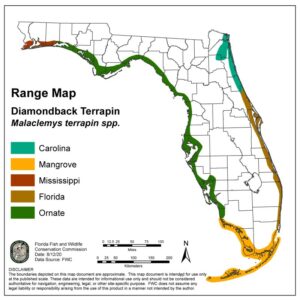
Diamondback terrapins (Malaclemys terrapin) are the only brackish water turtles in the United States. These terrapins inhabit coastal marshes and mangroves from Cape Cod MA to Brownsville TX. The population status of this animal has changed over time with commercial harvest, incidental take in the blue crab fishery, and loss of nesting habitat due to coastal development. Many become roadkill on highways, drowned in crab pots, and up to 90% of their nest are depredated by the raccoon (and other animals). Today the illegal pet trade has added extra pressure to indigenous populations. Within this range there is a large knowledge data gap concerning their status in the Florida panhandle. It is not known how frequently they are nesting, if populations are stable, or if there are issues with derelict fishing gear and illegal harvest. This is a national and state concern.
In response to the knowledge gap, Florida Sea Grant agents with University of Florida/IFAS Extension in the Florida panhandle partnered with United States Geological Survey (USGS) to develop the Panhandle Terrapin Project. The goal of this project is to train citizen science volunteers to survey known, and potential, nesting beaches for the frequency of nesting, predation of those nests, number of individual heads found in the lagoons, and assist the USGS with mark-recapture of these animals. Volunteer data collection continues so that federal and state natural resource managers have a long-term dataset for critical management planning.
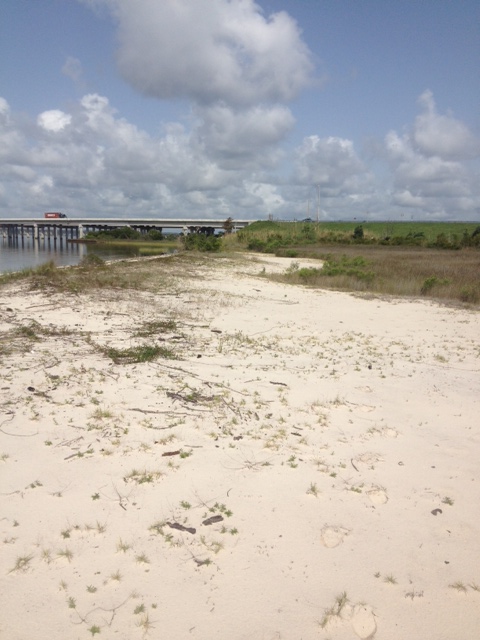
Terrapins prefer sandy beaches and lay their eggs during daylight hours. Photo: Molly O’Connor
Terrapins have strong site fidelity (they’re ‘homebodies’), meaning they do not roam much, and spend most of their day basking in the sun and feeding on shellfish – marsh snails being a particular favorite.
The small, emydid turtle is the only one that lives in brackish water and prefers salt marshes. Their nesting season historically begins in late April.
Like many species of turtle, they breed in the spring. Gravid females leave the marsh seeking high dry sandy beaches along the shores of the estuary to lay their eggs. Unlike sea turtles, diamondback terrapins prefer to do this on sunny days – the sunnier the better. Females typically lay between 7-10 eggs, and they hatch in about two months. The hatchlings spend their early months on shore, hiding under wrack and debris feeding on small invertebrates before heading to the marsh where the cycle begins again.
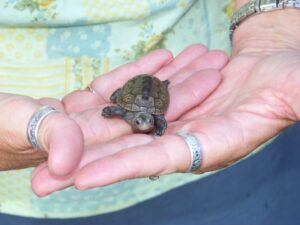
A terrapin hatchling.
Photo: Molly O’Connor
More To Explore
Eyes on Seagrass in the Indian River Lagoon Blitz
- Help "keep eyes" on the health the Indian River Lagoon's seagrasses